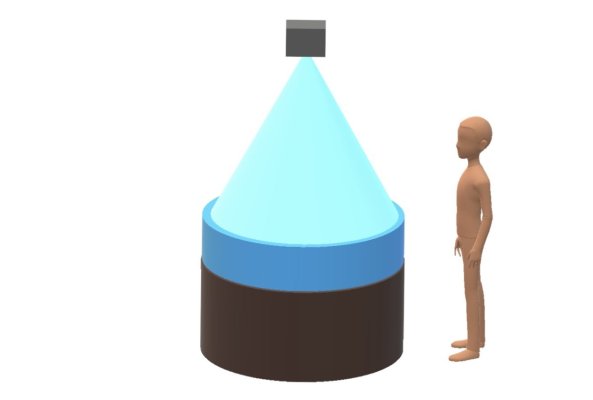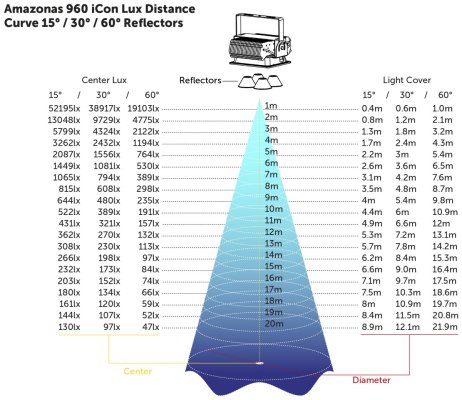- Joined
- May 7, 2017
- Messages
- 886
- Reaction score
- 1,122
Forgive the LONGGGG description, bear with me please....
Tank is a 60" diameter by 20" tall rimless cylinder. Stand will be around 30" tall. This new tank is predominately for my collection of Magnifica anemones, but I hope to also continue to grow my SPS frags. My 'vision' is as shown below (drawing not quite to scale).
I'm wanting to keep this set up as clean and free of equipment distractions as much as possible. This will be accomplished inside the tank via a hidden closed loop and an overflow located near the "back" of the cylinder, not centralized like most cylinder tanks.
The tank will often be viewed via top down/tide pool, which prompted my desire to keep lighting up high and out of the way as much as possible.
I am fortunate that in the room where the tank will be placed, the ceiling above the tank has a 2 foot open space above it with easy access from an adjacent unfinished room (which will serve as the 'fish room' where sump and all other equipment will be housed). I could mount lights, or a floating canopy, to the wall above the tank, but my hope is to mount the lighting 'on', or recessed 'in', the ceiling above the tank. My true desire is to have the lighting recessed in the ceiling with the bottom of the fixture flush with the ceiling.
If recessed in the ceiling, the light would be 60" above the water surface. So, when considering lights that could pull this off..........I came across one that could potentially be the perfect match.
Enter the Orphek Amazonas 960.
I've scoured the internet for over a year, gleaning as much info on the 960's as possible, but unfortunately, other than Orphek's specifications, there is very little second hand/hobbyist info or experience with them. I've read and reread all 960 related threads here on R2R, watched all videos and read all info Google can find me, and of course, watched the Tidal Gardens videos showcasing the 960s many times over.
According to Orphek's graphs, illustrations, and specs on their website, the Amazonas 960's are capable of putting out ALOT of par even when mounted several feet above the tank. With the proper reflectors, (15 degrees, 30 degrees, 60 degrees options available) the spread and intensity could be directed optimally to cover the entire surface area of this 60" diameter cylinder with little overspill outside the tank and provide more than enough par for high light demanding Magnifica and SPS corals.
In my case, at 60" above the tank, the 60 degree reflectors appear to be optimal.
Of course, this is how things appear 'on paper' but no real world applications similar to what I'm considering to be found. Hence me questioning this idea and asking for advice.
Pros:
- Would be quite unique and look pretty cool.
- Nothing in the way of top down viewing or when working in the tank.
- One light fixture, with lots of controllability, and surprisingly not too expensive when compared to multiple Radion XR 30's and the Kessil 500X's needed, could light the entire tank.
- Orphek LEDs are really good.
Potential Cons:
- Glare from the light on the eyes, being that it's mounted so high up, during normal seated side viewing? My thought to counter this is to mount the 960 fixture slightly off center, towards the front of the tank, and angle it slightly towards the 'back' of the tank? I'm thinking this will keep it from shining in my eyes when seated with a side benefit of slowing algae growth on the front viewing area.
- Heat dissipation is a concern when recessed in the ceiling. Counter that with a small fan mounted in the ceiling next to the fixture that would come on when the 960 comes on.
- Possibility that it won't light the tank, as hoped and per specs, when mounted this high.
So, there you have it. This is my idea. Thoughts? Suggestions? Advice? Very much open to other ideas!
Thanks everyone!

Tank is a 60" diameter by 20" tall rimless cylinder. Stand will be around 30" tall. This new tank is predominately for my collection of Magnifica anemones, but I hope to also continue to grow my SPS frags. My 'vision' is as shown below (drawing not quite to scale).
I'm wanting to keep this set up as clean and free of equipment distractions as much as possible. This will be accomplished inside the tank via a hidden closed loop and an overflow located near the "back" of the cylinder, not centralized like most cylinder tanks.
The tank will often be viewed via top down/tide pool, which prompted my desire to keep lighting up high and out of the way as much as possible.
I am fortunate that in the room where the tank will be placed, the ceiling above the tank has a 2 foot open space above it with easy access from an adjacent unfinished room (which will serve as the 'fish room' where sump and all other equipment will be housed). I could mount lights, or a floating canopy, to the wall above the tank, but my hope is to mount the lighting 'on', or recessed 'in', the ceiling above the tank. My true desire is to have the lighting recessed in the ceiling with the bottom of the fixture flush with the ceiling.
If recessed in the ceiling, the light would be 60" above the water surface. So, when considering lights that could pull this off..........I came across one that could potentially be the perfect match.
Enter the Orphek Amazonas 960.
I've scoured the internet for over a year, gleaning as much info on the 960's as possible, but unfortunately, other than Orphek's specifications, there is very little second hand/hobbyist info or experience with them. I've read and reread all 960 related threads here on R2R, watched all videos and read all info Google can find me, and of course, watched the Tidal Gardens videos showcasing the 960s many times over.
According to Orphek's graphs, illustrations, and specs on their website, the Amazonas 960's are capable of putting out ALOT of par even when mounted several feet above the tank. With the proper reflectors, (15 degrees, 30 degrees, 60 degrees options available) the spread and intensity could be directed optimally to cover the entire surface area of this 60" diameter cylinder with little overspill outside the tank and provide more than enough par for high light demanding Magnifica and SPS corals.
In my case, at 60" above the tank, the 60 degree reflectors appear to be optimal.
Of course, this is how things appear 'on paper' but no real world applications similar to what I'm considering to be found. Hence me questioning this idea and asking for advice.
Pros:
- Would be quite unique and look pretty cool.
- Nothing in the way of top down viewing or when working in the tank.
- One light fixture, with lots of controllability, and surprisingly not too expensive when compared to multiple Radion XR 30's and the Kessil 500X's needed, could light the entire tank.
- Orphek LEDs are really good.
Potential Cons:
- Glare from the light on the eyes, being that it's mounted so high up, during normal seated side viewing? My thought to counter this is to mount the 960 fixture slightly off center, towards the front of the tank, and angle it slightly towards the 'back' of the tank? I'm thinking this will keep it from shining in my eyes when seated with a side benefit of slowing algae growth on the front viewing area.
- Heat dissipation is a concern when recessed in the ceiling. Counter that with a small fan mounted in the ceiling next to the fixture that would come on when the 960 comes on.
- Possibility that it won't light the tank, as hoped and per specs, when mounted this high.
So, there you have it. This is my idea. Thoughts? Suggestions? Advice? Very much open to other ideas!
Thanks everyone!

Last edited:

















